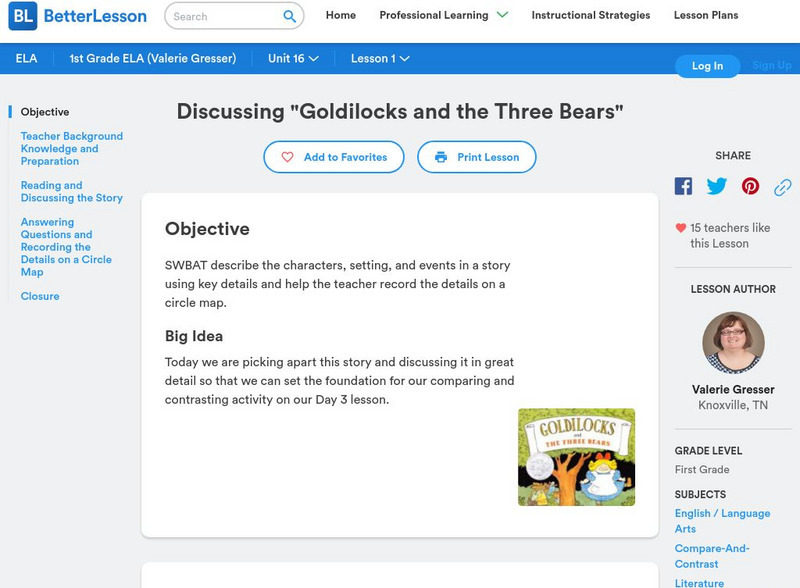Hi, what do you want to do?
Curated OER
Spotting Hidden Vowels
First graders recognize the short vowel i in written and spoken language. Through listening activities, they discriminate the vowel sound /i/ from other phonemes. Students associate the phoneme with its letter representation and identify...
Curated OER
Abigail Ant
Students recognize the short vowel a in written and spoken language. Through matching and listening activities, they discriminate the vowel sound /a/ from other phonemes. Students identify the phoneme and letter in words and pictures.
Curated OER
I Am Tired
First graders recognize the short vowel o in written and spoken language. Through listening and matching activities, they discriminate the vowel sound /o/ from other phonemes. Students associate the phoneme with its letter representation...
Curated OER
A's Baseball
First graders distinguish between short vowel a and long vowel a. They are introduced to the vowel-consonant-e pattern that changes short vowel sounds into long vowel sounds. They practice reading words with the vowel-consonant-e pattern.
Curated OER
Ouch! I have a booboo
First graders recognize the short vowel o in written and spoken language. Through matching activities, they discriminate the short vowel /u/ spelled ou from the short vowel /u/ spelled u. Students associate the phoneme with its letter...
Curated OER
The Baby is Crying
Students recognize the short vowel a in written and spoken language. Through matching activities, they discriminate the short vowel /a/ from other phonemes. Students associate the phoneme with its letter representation and identify the...
Curated OER
Cultural Corner- "Mexico"
Students use print and electronic resources to gather information about Mexico. They present a mini-museum to share with students, parents, and other interested classes around the district. They present their information in a video...
Curated OER
Open Wide
Students recognize the short vowel o in written and spoken language. Through matching and listening activities, they discriminate the vowel sound /o/ from other phonemes. Students associate the phoneme with its letter representation in...
Curated OER
Chimps Chugging Chocolate Milk
First graders identify the digraph /ch/ in written and spoken language. After a brief discussion of the independent and combined sounds of the phonemes /c/ and /h/ students practice identifying initial and final placement of the new...
Curated OER
Cry Baby
Students complete a variety of activities related to the short /a/ sound. They listen to a list of words and identify the words containing the short /a/ sound, and write the letter A. Students listen to the book "Cat Nap" and identify...
Curated OER
The Icky-Sticky Sound
Pupils recognize the short vowel i in written and spoken language. Through listening activities, they discriminate the vowel sound /i/ from other phonemes. Students associate the phoneme with its letter representation and identify the...
Utah Education Network
Uen: Lesson Plan: Maps and Me
Lesson to reinforce basic map skills. Learners discuss Me on the Map by Joan Sweeney, work in groups to create maps of the classroom, and use these maps to hunt for treasure.
Alabama Learning Exchange
Alex: Primary Technology Maps
This hands-on, inquiry-based lesson combines maps skills which include identifying map elements, applying an understanding of cardinal directions, interpreting resource maps, and identifying a location. Young scholars will have the...
Better Lesson
Better Lesson: Comparing and Contrasting Our Stories With a Double Bubble Map
Students will identify the similarities and differences between different versions of fictional stories by completing a double bubble map. Included in this lesson are teacher questions, a bubble map printable, a video of a class...
The Newberry Library
Newberry Library: Historic Maps in K 12 Classrooms
Great resource for teachers of geography and American history for all levels. You will find lesson plans based on the use of maps for all ages.
HotChalk
Hot Chalk: Lesson Plans Page: Find Captain Hook's Treasure
Lesson that helps students understand maps, map directions, and map symbols. Students use teacher-created maps to locate numbered keys on the playground.
Better Lesson
Better Lesson: Discussing "Goldilocks and the Three Bears"
Today we are picking apart this story and discussing it in great detail so that we can set the foundation for our comparing and contrasting activity on our Day 3 lesson.
Better Lesson
Better Lesson: Discussing "The True Story of the Three Little Pigs"
In this lesson, 1st graders will work with "The True Story of the Three Little Pigs" Jon Scieszkaby. They will describe the characters, setting, and key details in the story and help the teacher record the details on a circle map.






















